Fabrication of Pre-Structured Substrates and Growth of CIGS Micro-Absorbers
Abstract
1. Introduction
2. Materials and Methods
2.1. Pre-Structured Substrate Fabrication
2.2. Structuring the Substrate
2.3. CIG Precursor Deposition followed by 2-Stage Selenization
2.4. Characterization Methods
3. Results and Discussion
3.1. Pre-Structured Substrate
3.2. CIGS Growth
4. Conclusions
Author Contributions
Funding
Data Availability Statement
Acknowledgments
Conflicts of Interest
References
- Masson, G.; Bosch, E.; van Rechem, A.; de I’Epine, M.; Kaizuka, I.; Jäger-Waldau, A.; Donoso, J. Snapshot of Global PV Markets 2023; International Energy Agency, Photovoltaic Power Systems Programme: Paris, France, 2023. [Google Scholar]
- Feldman, D.; Zuboy, J.; Dummit, K.; Stright, D.; Heine, M.; Mirletz, H.; Margolis, R. Winter 2024 Solar Industry Update; National Renewable Energy Laboratory (NREL): Golden, CO, USA, 2024. [Google Scholar]
- Philipps, S.; Warmuth, W.; Bett, A.W.; Burger, B.; Friedrich, L.; Kost, C.; Nold, S.; Peper, D.; Preu, R.; Rentsch, J.; et al. Photovoltaics Report. Available online: https://www.ise.fraunhofer.de/content/dam/ise/de/documents/publications/studies/Photovoltaics-Report.pdf (accessed on 3 January 2024).
- Slade, A.; Garboushian, V. 27.6% Efficient Silicon Concentrator Solar Cells for MassProduction. In Proceedings of the 15th International Photovoltaic Science and Engineering Conference, Shanghai, China, 10–15 October 2005; p. 701. [Google Scholar]
- Green, M.A.; Dunlop, E.D.; Yoshita, M.; Kopidakis, N.; Bothe, K.; Siefer, G.; Hao, X. Solar Cell Efficiency Tables (Version 62). Prog. Photovoltaics Res. Appl. 2023, 31, 651–663. [Google Scholar] [CrossRef]
- Kashyap, S.; Madan, J.; Pandey, R.; Sharma, R. Comprehensive Study on the Recent Development of PERC Solar Cell. Conf. Rec. IEEE Photovolt. Spec. Conf. 2020, 2020, 2542–2546. [Google Scholar] [CrossRef]
- Keller, J.; Kiselman, K.; Donzel-Gargand, O.; Martin, N.M.; Babucci, M.; Lundberg, O.; Wallin, E.; Stolt, L.; Edoff, M. High-Concentration Silver Alloying and Steep Back-Contact Gallium Grading Enabling Copper Indium Gallium Selenide Solar Cell with 23.6% Efficiency. Nat. Energy 2024. [Google Scholar] [CrossRef]
- Ward, J.S.; Egaas, B.; Noufi, R.; Contreras, M.; Ramanathan, K.; Osterwald, C.; Emery, K. Cu(In,Ga)Se2 Solar Cells Measured under Low Flux Optical Concentration. In Proceedings of the 2014 IEEE 40th Photovoltaic Specialist Conference (PVSC), Denver, CO, USA, 8–13 June 2014; pp. 2934–2937. [Google Scholar]
- Khamooshi, M.; Salati, H.; Egelioglu, F.; Hooshyar Faghiri, A.; Tarabishi, J.; Babadi, S. A Review of Solar Photovoltaic Concentrators. Int. J. Photoenergy 2014, 2014, 958521. [Google Scholar] [CrossRef]
- Wiesenfarth, M.; Anton, I.; Bett, A.W. Challenges in the Design of Concentrator Photovoltaic (CPV) Modules to Achieve Highest Efficiencies. Appl. Phys. Rev. 2018, 5, 041601. [Google Scholar] [CrossRef]
- Dimroth, F.; Tibbits, T.N.D.; Niemeyer, M.; Predan, F.; Beutel, P.; Karcher, C.; Oliva, E.; Siefer, G.; Lackner, D.; Fus-Kailuweit, P.; et al. Four-Junction Wafer-Bonded Concentrator Solar Cells. IEEE J. Photovoltaics 2016, 6, 343–349. [Google Scholar] [CrossRef]
- Kayes, B.M.; Zhang, L.; Twist, R.; Ding, I.K.; Higashi, G.S. Flexible Thin-Film Tandem Solar Cells with >30% Efficiency. IEEE J. Photovoltaics 2014, 4, 729–733. [Google Scholar] [CrossRef]
- Paire, M.; Lombez, L.; Guillemoles, J.F.; Lincot, D. Toward Microscale Cu(In,Ga)Se2 Solar Cells for Efficient Conversion and Optimized Material Usage: Theoretical Evaluation. J. Appl. Phys. 2010, 108, 034907. [Google Scholar] [CrossRef]
- Domínguez, C.; Jost, N.; Askins, S.; Victoria, M.; Antón, I. A Review of the Promises and Challenges of Micro-Concentrator Photovoltaics. AIP Conf. Proc. 2017, 1881, 080003. [Google Scholar] [CrossRef]
- Paire, M.; Lombez, L.; Donsanti, F.; Jubault, M.; Lincot, D.; Guillemoles, J.-F.; Collin, S.; Pelouard, J.-L. Thin-Film Microcells: A New Generation of Photovoltaic Devices. SPIE Newsroom 2013, 5, 2–3. [Google Scholar] [CrossRef]
- Alves, M.; Pérez-Rodríguez, A.; Dale, P.J.; Domínguez, C.; Sadewasser, S. Thin-Film Micro-Concentrator Solar Cells. J. Phys. Energy 2020, 2, 012001. [Google Scholar] [CrossRef]
- Sadewasser, S.; Salomé, P.M.P.; Rodriguez-Alvarez, H. Materials Efficient Deposition and Heat Management of CuInSe2 Micro-Concentrator Solar Cells. Sol. Energy Mater. Sol. Cells 2017, 159, 496–502. [Google Scholar] [CrossRef]
- Paire, M.; Shams, A.; Lombez, L.; Péré-Laperne, N.; Collin, S.; Pelouard, J.L.; Guillemoles, J.F.; Lincot, D. Resistive and Thermal Scale Effects for Cu(In,Ga)Se2 Polycrystalline Thin Film Microcells under Concentration. Energy Environ. Sci. 2011, 4, 4972–4977. [Google Scholar] [CrossRef]
- Paire, M.; Lombez, L.; Péré-Laperne, N.; Collin, S.; Pelouard, J.-L.; Lincot, D.; Guillemoles, J.-F. Microscale Solar Cells for High Concentration on Polycrystalline Cu(In,Ga)Se2 Thin Films. Appl. Phys. Lett. 2011, 98, 264102. [Google Scholar] [CrossRef]
- Paire, M.; Lombez, L.; Donsanti, F.; Jubault, M.; Collin, S.; Pelouard, J.L.; Guillemoles, J.F.; Lincot, D. Cu(In, Ga)Se2 Microcells: High Efficiency and Low Material Consumption. J. Renew. Sustain. Energy 2013, 5, 011202. [Google Scholar] [CrossRef]
- Paire, M.; Jean, C.; Lombez, L.; Collin, S.; Pelouard, J.-L.; Gérard, I.; Guillemoles, J.-F.; Lincot, D. Cu(In,Ga)Se2 Mesa Diodes for the Study of Edge Recombination. Thin Solid Films 2015, 582, 258–262. [Google Scholar] [CrossRef]
- Reinhold, B.; Schmid, M.; Greiner, D.; Schüle, M.; Kieven, D.; Ennaoui, A.; Lux-steiner, M.C. Monolithically Interconnected Lamellar Cu(In,Ga)Se2 Micro Solar Cells under Full White Light Concentration. Prog. Photovoltaics Res. Appl. 2015, 23, 1929–1939. [Google Scholar] [CrossRef]
- Ringleb, F.; Andree, S.; Heidmann, B.; Bonse, J.; Eylers, K.; Ernst, O.; Boeck, T.; Schmid, M.; Krüger, J. Femtosecond Laser-Assisted Fabrication of Chalcopyrite Micro-Concentrator Photovoltaics. Beilstein J. Nanotechnol. 2018, 9, 3025–3038. [Google Scholar] [CrossRef]
- Heidmann, B.; Ringleb, F.; Eylers, K.; Levcenco, S.; Bonse, J.; Andree, S.; Krüger, J.; Unold, T.; Boeck, T.; Lux-Steiner, M.C.; et al. Local Growth of CuInSe2 Micro Solar Cells for Concentrator Application. Mater. Today Energy 2017, 6, 238–247. [Google Scholar] [CrossRef]
- Correia, D.; Siopa, D.; Colombara, D.; Tombolato, S.; Salomé, P.M.P.; Abderrafi, K.; Anacleto, P.; Dale, P.J.; Sadewasser, S. Area-Selective Electrodeposition of Micro Islands for CuInSe2-Based Photovoltaics. Results Phys. 2019, 12, 2136–2140. [Google Scholar] [CrossRef]
- Siopa, D.; El Hajraoui, K.; Tombolato, S.; Babbe, F.; Lomuscio, A.; Wolter, M.H.; Anacleto, P.; Abderrafi, K.; Deepak, F.L.; Sadewasser, S.; et al. Micro-Sized Thin-Film Solar Cells via Area-Selective Electrochemical Deposition for Concentrator Photovoltaics Application. Sci. Rep. 2020, 10, 14763. [Google Scholar] [CrossRef]
- Fuster, D.; Anacleto, P.; Virtuoso, J.; Zutter, M.; Brito, D.; Alves, M.; Aparicio, L.; Fuertes Marrón, D.; Briones, F.; Sadewasser, S.; et al. System for Manufacturing Complete Cu(In,Ga)Se2 Solar Cells in Situ under Vacuum. Sol. Energy 2020, 198, 490–498. [Google Scholar] [CrossRef]
- Hu, D.; Ma, B.; Li, X.; Lv, Y.; Chen, Y.; Wang, C. Innovative and Sustainable Separation and Recovery of Valuable Metals in Spent CIGS Materials. J. Clean. Prod. 2022, 350, 131426. [Google Scholar] [CrossRef]
- Duchatelet, A.; Nguyen, K.; Grand, P.P.; Lincot, D.; Paire, M. Self-Aligned Growth of Thin Film Cu(In,Ga)Se2 Solar Cells on Various Micropatterns. Appl. Phys. Lett. 2016, 109, 253901. [Google Scholar] [CrossRef]
- Poeira, R.G.; Pérez-Rodríguez, A.; Prot, A.J.M.; Alves, M.; Dale, P.J.; Sadewasser, S. Direct Fabrication of Arrays of Cu(In,Ga)Se2 Micro Solar Cells by Sputtering for Micro-Concentrator Photovoltaics. Mater. Des. 2023, 225, 111597. [Google Scholar] [CrossRef]
- Ramanujam, J.; Singh, U.P. Copper Indium Gallium Selenide Based Solar Cells—A Review. Energy Environ. Sci. 2017, 10, 1306–1319. [Google Scholar] [CrossRef]
- Zaretskaya, E.P.; Gremenok, V.F.; Riede, V.; Schmitz, W.; Bente, K.; Zalesski, V.B.; Ermakov, O.V. Raman Spectroscopy of CuInSe2 Thin Films Prepared by Selenization. J. Phys. Chem. Solids 2003, 64, 1989–1993. [Google Scholar] [CrossRef]
- Choi, I.H. Raman Spectroscopy of CuIn1−XGaxSe2 for in-Situ Monitoring of the Composition Ratio. Thin Solid Films 2011, 519, 4390–4393. [Google Scholar] [CrossRef]
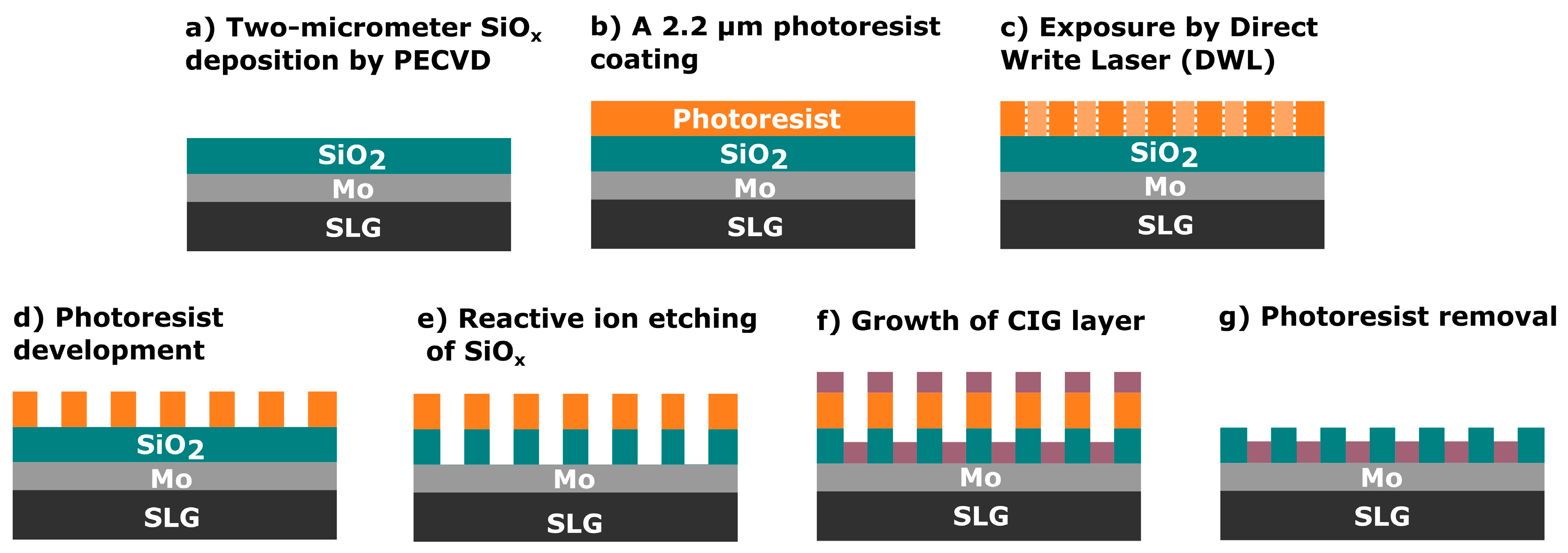
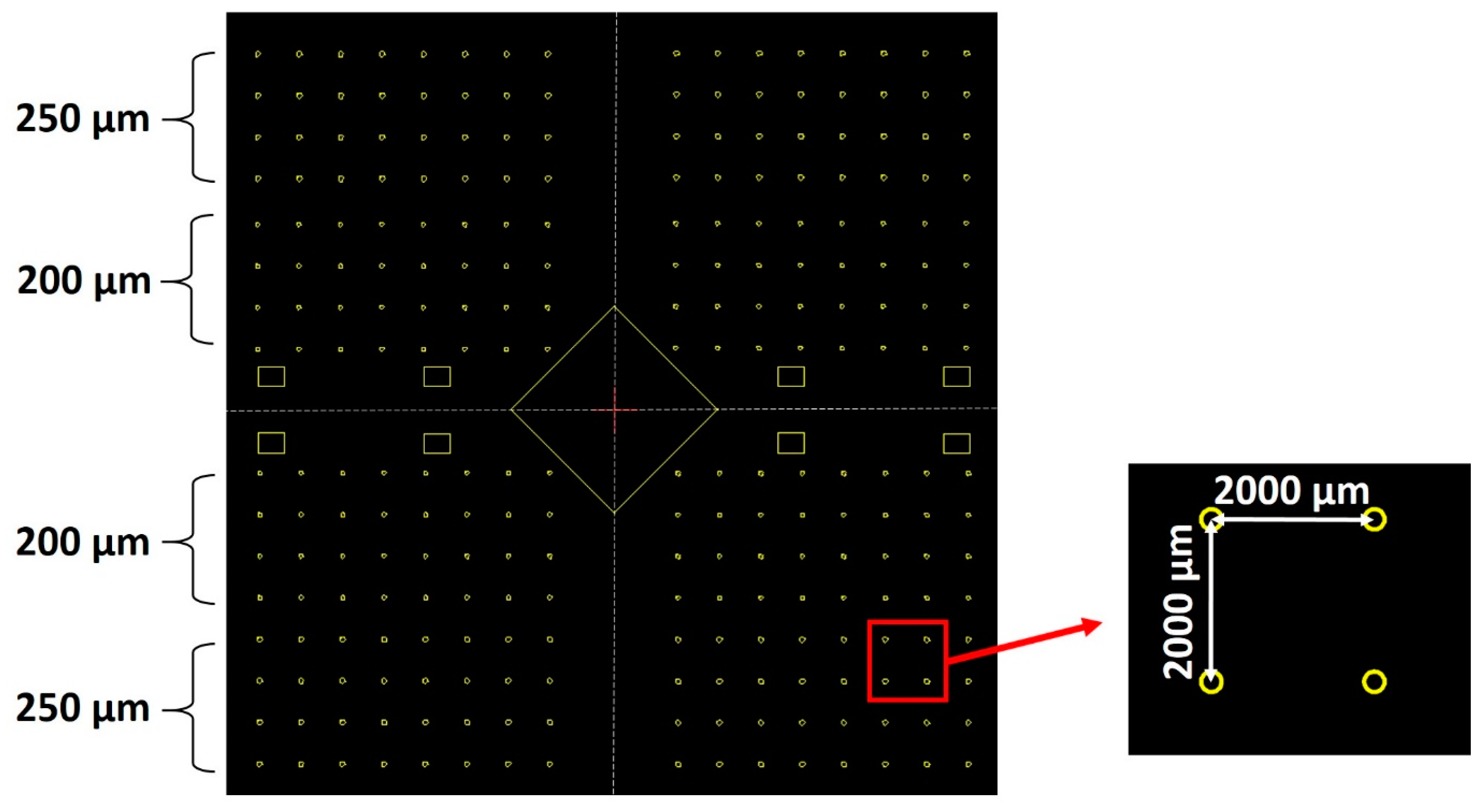
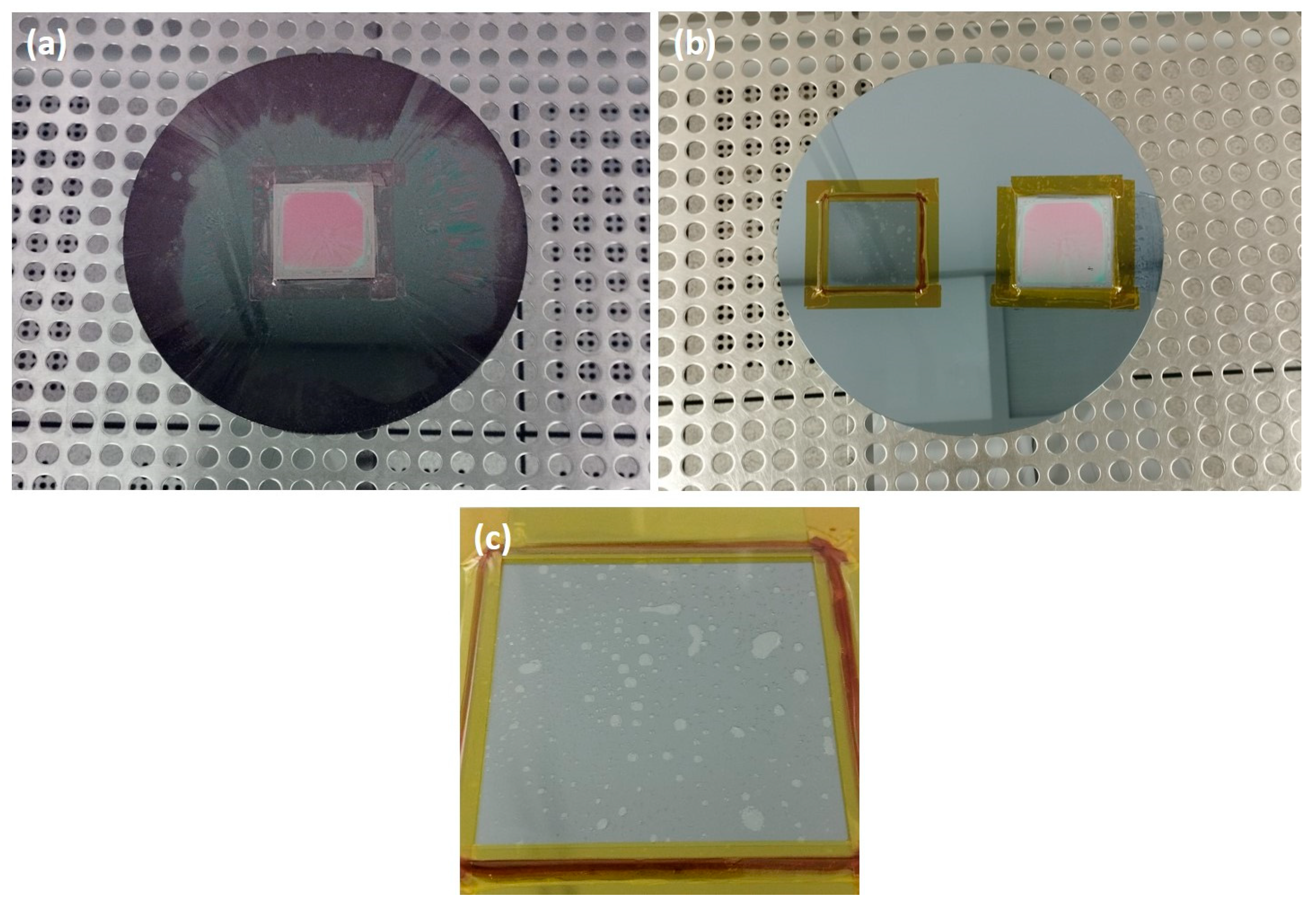
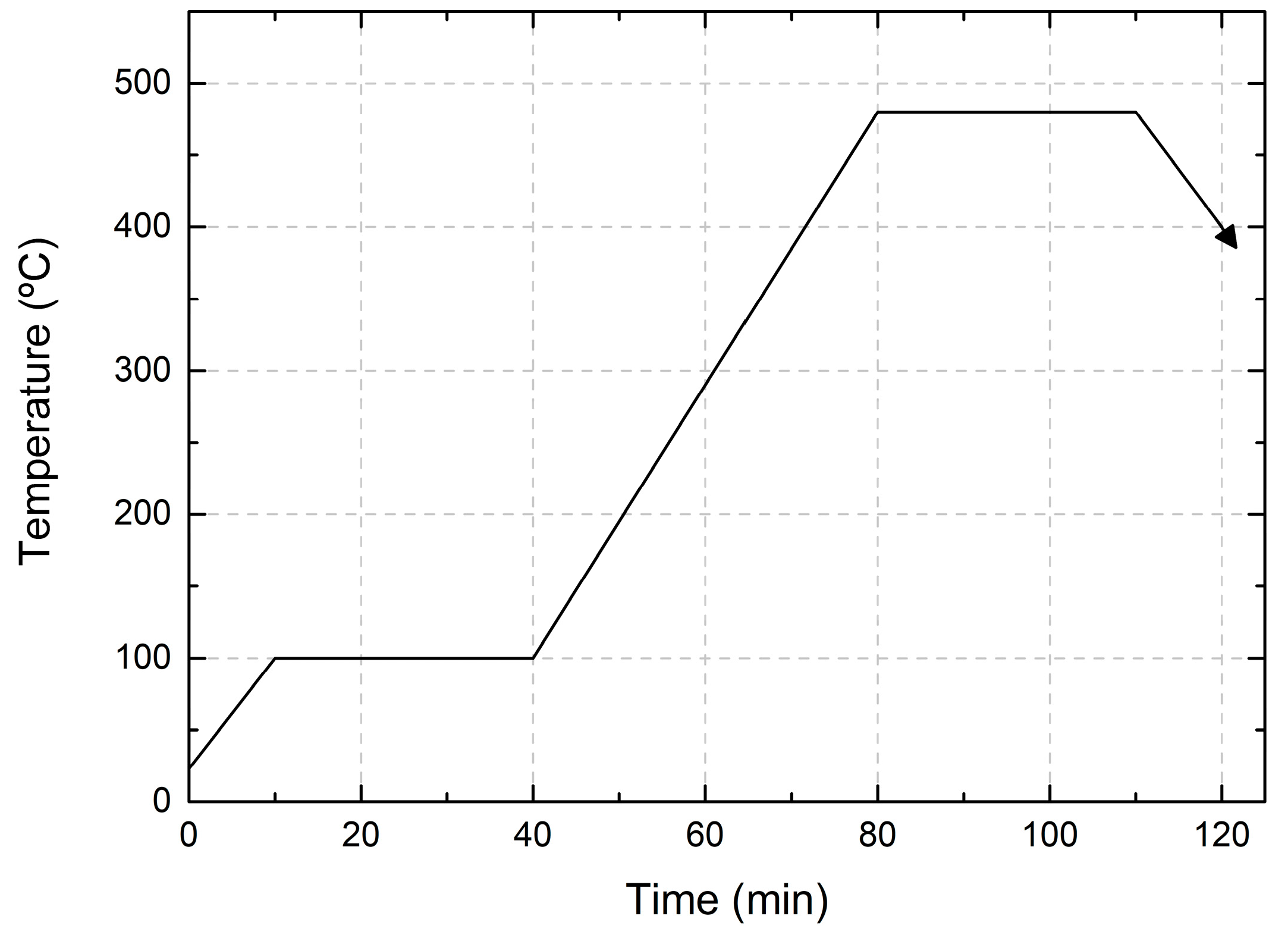


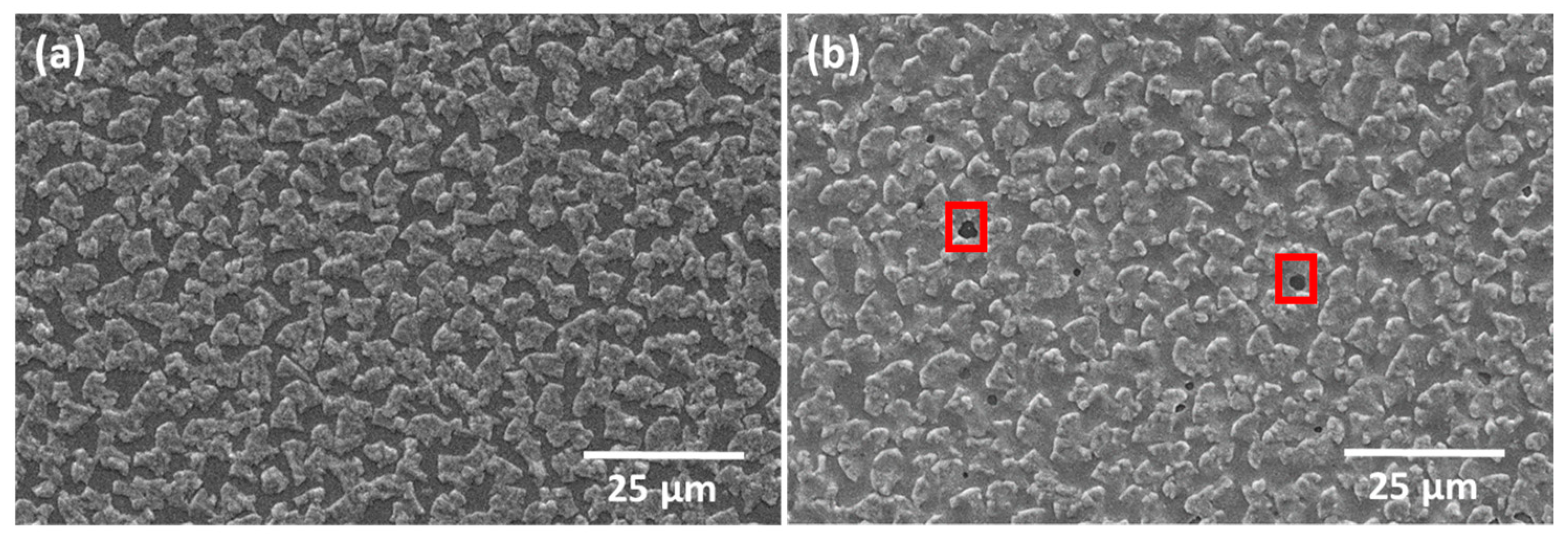
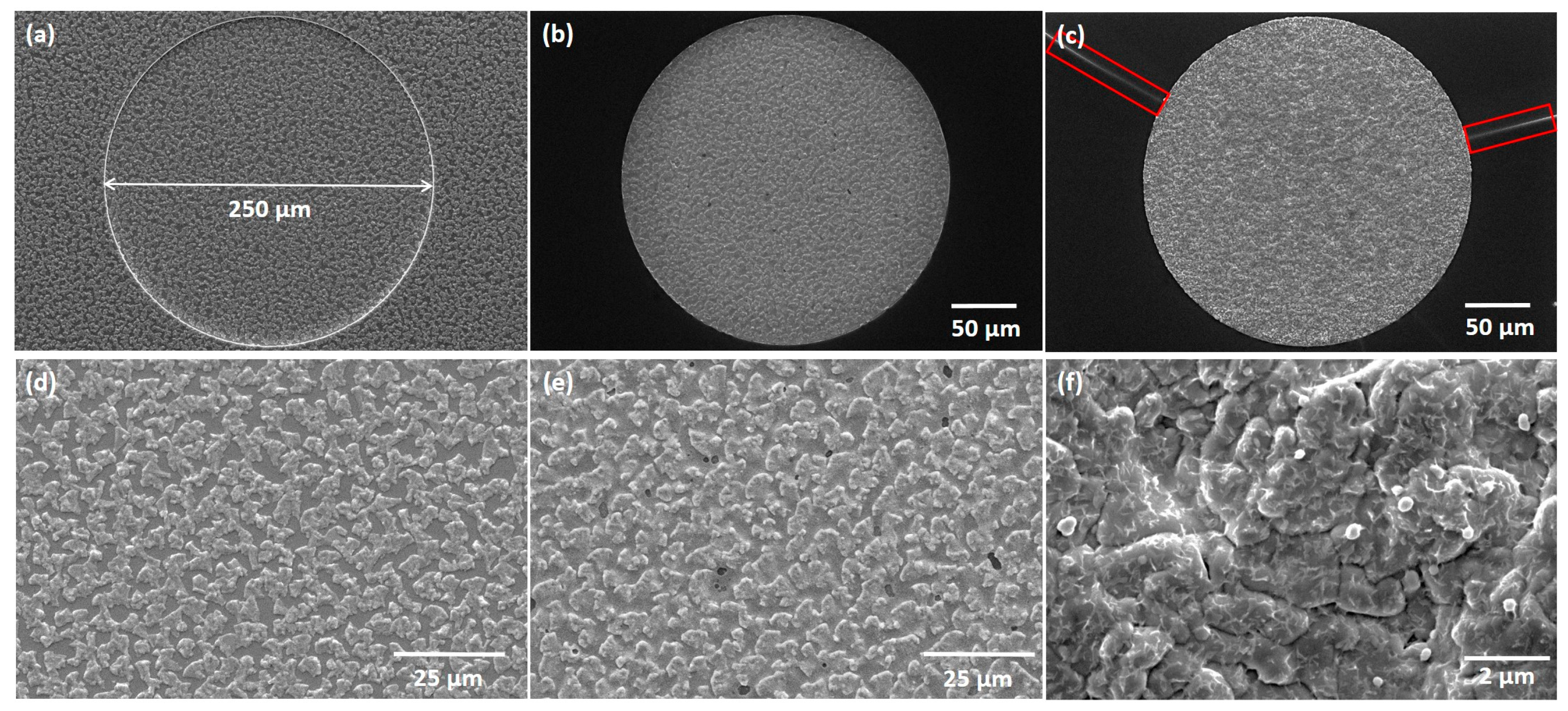
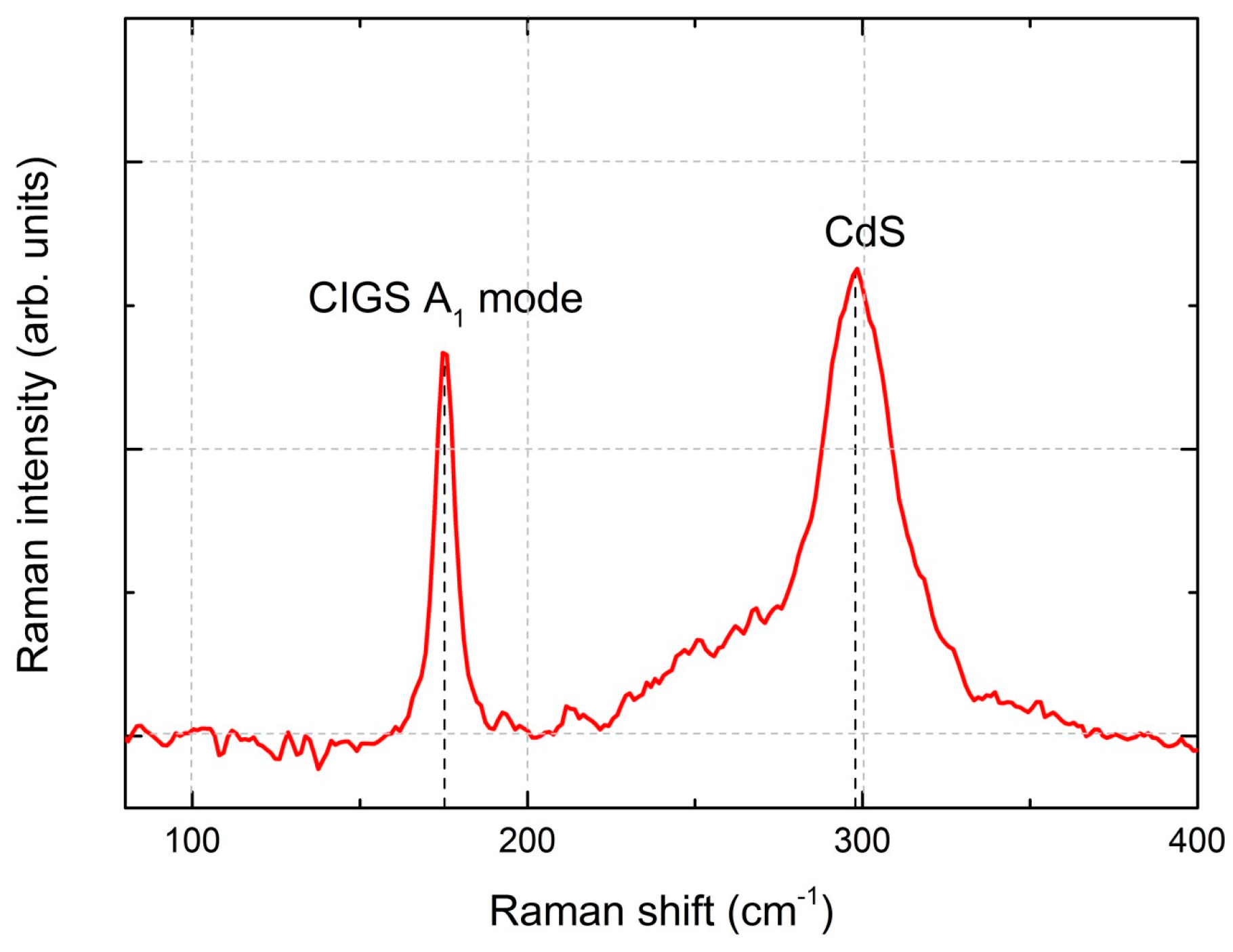
| Fabrication | Deposition Method | Material | Size of Micro Solar Cell (µm) | Efficiency under 1 Sun (%) | Efficiency under Concentration (%) | Reference |
|---|---|---|---|---|---|---|
| Top-Down | ||||||
| Photolithography after buffer | Co-evaporation | Cu(In,Ga)Se2 | 15 | 13 | 17 (×120) | [19] |
| Photolithography after i-ZnO | Co-evaporation | Cu(In,Ga)Se2 | 15 | ~14 | ~17 | [18] |
| 25 | ~11.5 | ~16.5 (×120) | ||||
| 50 | ~13 | ~16.5 | ||||
| Photolithography after i-ZnO | Co-evaporation | Cu(In,Ga)Se2 | 50 | 16.3 | 21.3 (×475) | [15] |
| Photolithography and chemical etching | Co-evaporation | Cu(In,Ga)Se2 | 40 | ~13 | ~17 (×100) | [21] |
| 250 | ~11.5 | ~15 (×40) | ||||
| P1, P2, and P3 scribing | Co-evaporation | Cu(In,Ga)Se2 | 1000 * | 13.5 | 15 (×6) | [22] |
| 500 * | 11.8 | 14.6 (×8) | ||||
| 750 (dot-shaped) | 13.6 | 17.6 (×51) | ||||
| Bottom-Up | ||||||
| Patterned substrate | PVD | CuInSe2 | 40–60 | 2.9 | 3.1 (×3) | [24] |
| Laser-patterned substrate | Nucleation (PVD) | CuInSe2 Cu(In,Ga)Se2 | ~400 | 2.9 | 3.06 (×3) | [23] |
| 1.4 | 3.36 (×20) | |||||
| Laser-patterned substrate | LIFT | Cu(In,Ga)Se2 | ~490 | 0.15 | 0.237 (×20) | [23] |
| Patterned substrate | Area-selective electrodeposition | CuInSe2 | 200 | 4.8 | - | [25] |
| Patterned substrate | Area-selective electrodeposition | Cu(In,Ga)Se2 | 200 | 4.8 | 5.2 (×3) | [26] |
| Sample | Composition (at %) | Ratios | ||||
|---|---|---|---|---|---|---|
| Cu | In | Ga | Se | CGI | GGI | |
| CIG | 46 ± 1.9 | 38 ± 1.8 | 13 ± 1.0 | - | 0.88 ± 0.04 | 0.26 ± 0.02 |
| CIG500 | 45 ± 1.7 | 39 ± 1.7 | 15 ± 1.8 | - | 0.84 ± 0.04 | 0.28 ± 0.03 |
| CIGS | 24 ± 0.8 | 20 ± 1.5 | 5 ± 1.5 | 50 ± 0.9 | 1.00 ± 0.04 | 0.20 ± 0.06 |
Disclaimer/Publisher’s Note: The statements, opinions and data contained in all publications are solely those of the individual author(s) and contributor(s) and not of MDPI and/or the editor(s). MDPI and/or the editor(s) disclaim responsibility for any injury to people or property resulting from any ideas, methods, instructions or products referred to in the content. |
© 2024 by the authors. Licensee MDPI, Basel, Switzerland. This article is an open access article distributed under the terms and conditions of the Creative Commons Attribution (CC BY) license (https://creativecommons.org/licenses/by/4.0/).
Share and Cite
Alves, M.; Anacleto, P.; Teixeira, V.; Carneiro, J.; Sadewasser, S. Fabrication of Pre-Structured Substrates and Growth of CIGS Micro-Absorbers. Nanomaterials 2024, 14, 543. https://doi.org/10.3390/nano14060543
Alves M, Anacleto P, Teixeira V, Carneiro J, Sadewasser S. Fabrication of Pre-Structured Substrates and Growth of CIGS Micro-Absorbers. Nanomaterials. 2024; 14(6):543. https://doi.org/10.3390/nano14060543
Chicago/Turabian StyleAlves, Marina, Pedro Anacleto, Vasco Teixeira, Joaquim Carneiro, and Sascha Sadewasser. 2024. "Fabrication of Pre-Structured Substrates and Growth of CIGS Micro-Absorbers" Nanomaterials 14, no. 6: 543. https://doi.org/10.3390/nano14060543
APA StyleAlves, M., Anacleto, P., Teixeira, V., Carneiro, J., & Sadewasser, S. (2024). Fabrication of Pre-Structured Substrates and Growth of CIGS Micro-Absorbers. Nanomaterials, 14(6), 543. https://doi.org/10.3390/nano14060543








